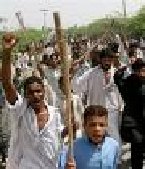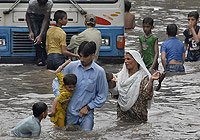Owais Mughal
 Baluchistan was hit by a cyclone named ‘Yemyeni’ four days ago and it has caused widespread havoc. BBC news site is reporting that 800000 people have been affected. Today there are even reports of rioting by the hungry people waiting for aid to arrive. Worst affected area is reported to be Turbat where water over ran the embankments of Mirani dam. Government aid has started pouring in slowly but a lot needs to be done. The detailed news about the cyclone and rain havoc across Baluchistan is all over the national and international media therefore at ATP we will let following images do the talking. The title photo above is of a submerged Turbat mosque.
Baluchistan was hit by a cyclone named ‘Yemyeni’ four days ago and it has caused widespread havoc. BBC news site is reporting that 800000 people have been affected. Today there are even reports of rioting by the hungry people waiting for aid to arrive. Worst affected area is reported to be Turbat where water over ran the embankments of Mirani dam. Government aid has started pouring in slowly but a lot needs to be done. The detailed news about the cyclone and rain havoc across Baluchistan is all over the national and international media therefore at ATP we will let following images do the talking. The title photo above is of a submerged Turbat mosque.
These photos have been linked to the news sites and clicking on them will take you to their parent websites.
(2)
 In this photo, the main road to Turbat is seen washed away in a flash flood. This photo is from thursday, June 28, 2007. Turbat city which has a population of 150000 is also without drinking water and electricity. Government of Pakistan has confirmed 14 deaths and 23 missing as of friday but this number may go higher once the water recedes.
In this photo, the main road to Turbat is seen washed away in a flash flood. This photo is from thursday, June 28, 2007. Turbat city which has a population of 150000 is also without drinking water and electricity. Government of Pakistan has confirmed 14 deaths and 23 missing as of friday but this number may go higher once the water recedes.
(3)
 In the photo to the right, angry protestors are seen walking towards the ‘nazim’ (mayor’s) office of Turbat. They are protesting slow and meager aid reaching their villages. The water from the hand-drwan wells has been rendered undrinkable due to floods and tube-wells which draw water from much deeper could not be operated because of power failure. Rauf Rind, nazim (mayor) of Kech said:
In the photo to the right, angry protestors are seen walking towards the ‘nazim’ (mayor’s) office of Turbat. They are protesting slow and meager aid reaching their villages. The water from the hand-drwan wells has been rendered undrinkable due to floods and tube-wells which draw water from much deeper could not be operated because of power failure. Rauf Rind, nazim (mayor) of Kech said:
“The entire town has been inundated and people have taken refuge in tall buildings and trees”.
Chakar Baloch who walked more than 40 km through the night to reach Turbat said:
“Every family is looking for one or two members”.
Others feared they would never see their missing family members again.
(4)
 Photo shows some of the problems that this cyclone has brought to people in the affected areas.
Photo shows some of the problems that this cyclone has brought to people in the affected areas.
More photos of Baluchistan rains can be seen at BBC news site here.



















































I think we should send e-mails to people like Shahid Masood, Hamid Mir etc asking them to repeat their performance of the earthquake’s coverage. I don’t have their e-mail addresses, and would appreciate if someone can post them here.
The sad part is that we are less concerned about the suffering of the people of Baluchistan and Sindh. Even when we think about the present disaster, we are more worried about the political fall out rather than the human tragedy of the deaths and 2 million people losing their homes and livelihoods.
Pakistan’s FEMA is called NDMA (National Disaster Management Authority ) http://ndma.gov.pk/ and if you have guessed then you are right, its chairman is a Major General. I also noticed it had a link to FEMA’s website.
here is good assesment of the relief situation
Fury over Pakistan flood relief
(http://news.bbc.co.uk/2/hi/south_asia/6262668.stm )
A cyclone has caused devastating floods in Pakistan’s Balochistan province, with more than 1,000,000 people hit and many thousands of homes destroyed. The BBC’s Ilyas Khan visited Turbat, one of the worst-affected towns. Here he assesses the aid operation.
——————————————————————————–
A local BBC reporter in Turbat, Tariq Masood, was among the first people to notice that the flood was upon them last Tuesday evening.
There have been angry scenes in Turbat
“It was the waning sound of the river that warned us,” he says.
An old man in the village of Ginna, on the right bank of the river where Mr Masood was visiting some friends, cocked his ears when the thud and rumble of the water flowing through the rocky sands of the riverbed gradually faded away, making the sound of the rain more audible.
“The silence was followed by a stale, almost rotten smell of damp earth. The old man said, ‘check out the river, there is something wrong’. But before we could go to the river, it came to us,” he says.
See a detailed map of the region
Ginna is one of 43 villages in the area that were hit by the floods that evening.
It took some time for the people in Turbat city centre to realise what had happened to the western villages on both banks of the river.
Not a single official was in the office, they were avoiding us because they couldn’t face the reality
Sardar Rafique Ahmad,
Koshkalat council head
Despair in Balochistan
Some came to know in the night when they received distress calls from friends and relatives caught up in the disaster. Others only knew in the morning, after having slept peacefully through the rainy night that broke the hot spell in this oasis town of the vast Mekran desert.
But the local administration was certainly not the last to know.
“A large group of people from Turbat centre was trying to get to Koshkalat village which had been flooded, but a small bridge on the road had been washed away and the waters were gushing through, blocking the road,” says Anwar Ali, a Turbat resident.
“We saw two police trucks, and the vehicle of the head of the district government, parked near the broken bridge. They waited for a while, then they turned and drove away,” he says.
But others persevered.
“We waited and some time after 0200 most of us were able to wade through the waters and make it to the road on the other side.”
‘No will’
That was the first and the last time that the head of the city government, Abdur Rauf Rind, was seen in the area.
[The government] has failed to show the skills to manage the crisis
Maula Bukhsh Dashti,
Ex-Turbat government head
On two consecutive days after the floods, the village councillors of Koshkalat and adjoining villages repeatedly visited the offices of the district officials, trying to get them to send a bulldozer to fix a couple of breaches in the road.
“Not a single official was in the office, they were avoiding us because they couldn’t face the reality,” says Sardar Rafique Ahmad, head of the Kushkalat local council.
Pakistani government officials deny the authorities are to blame for relief being slow to get through – and say the relatively low number of deaths proves this.
Despite repeated attempts, the BBC was unable to contact local officials to put villagers’ criticisms to them. Mr Rind, the head of Turbat’s city government, could not be reached on any of his four telephones.
A former head of the city government, Maula Bukhsh Dashti, says authorities in Turbat can arrange more than a dozen bulldozers from various government departments and a construction company which is building the road linking Turbat with a dam some 45km (30 miles) to the west.
The government can also arrange at least five large water tankers from various departments, he says.
“The government has the resources, but it does not have the will. It has failed to show the skills to manage the crisis,” he says.
In Quetta, the capital of Balochistan province in which Turbat is also located, the provincial government was equally slow in moving.
“Although we had received information of the flood within four hours, the government could not come up with a rescue and relief plan for the next three days,” says Nizamuddin, a lawyer from Turbat who is based in Quetta.
PM’s visit
Nizamuddin was part of a delegation that met Balochistan Chief Minister Jam Mohammad Yousuf to register their complaint about the delay in delivering relief.
Possessions have been swept away
“The chief minister said the relief operation will have to wait until the weather in Turbat clears,” he says.
But on that very day the Pakistan International Airlines (PIA) had resumed operations to Turbat and a PIA aircraft had landed there three hours before that meeting.
Prime Minister Shaukat Aziz waited for six days before visiting Turbat, and when he did, he avoided going into the affected areas and meeting the people.
On the contrary, his visit created more problems for the people.
The Turbat airport was closed to the public from an hour before his arrival around midday time on Sunday, until about 1600 when he departed.
About 50 passengers who were booked on an afternoon flight to Karachi, and their friends and relatives who came to see them off, were stranded outside the airport for almost four hours, battling with a sizzling sun.
Police guarding the gates had no information for passengers, such as when the gates would be opened, or when their flight – number PK-596 – would depart.
At least four of these passengers were going to Karachi for medical reasons. Among them, two passengers were seriously ill and were being carried on stretchers.
At least one sick woman had come from as far away as Mand on the Iranian border, 120km to the west of Turbat. Her relatives say they had to carry her across riverbeds at two points on the road where the floods have washed away the bridges.
Ammar,
I have read the link you attached in your comment. I think the people who write this nonsense are just heaping insult over injury of the poor and dispossessed. A person loses his house, his land and maybe some of his loved ones and, instead of helping him or condoling with him, you tell him that he/she deserved this because of the bad deeds or “sins” they have been committing.
It is always the poor who suffer the most when a calamity like this hits because they are the least protected. Does this mean it is only the poor people who sin? What kind of screwed up logic is this?
On a tangent I want to take people back to 1988. 3 months before the general elections there was massive flooding in Punjab. I remember seeing Nawaz Sharif on TV handing the victims blankets and food supplies in person. I remember seeing him putting his hand on the heads of the poor and consoling with them. That may have been an election gimmick, but these are the kind of scenes poeple like to see. We want our leaders to display this kind of sympathy and sensitivity in times of crisis.
In October 2005 I’d have liked Musharraf to immediately fly into Muzaffarabad at the sight where children buried under rubble were crying for help. On live TV he should’ve appealed to the entire world, “We need immediate assistance to rescue these children from under the rubble.” The cries of children in the background would’ve spurred the western world and Japan into immediate action.
I wanted to see him embrace the poor, put his hand on their heads and console with them. I never saw those images. It was the visiting Turkish PM who acted like this in 2005 while the stoic Shaukat Aziz merely looked on.
Musharraf, Shaukhat Aziz and our current leader are simply devoid of “dard” and sympathy for the poor and the desolate.